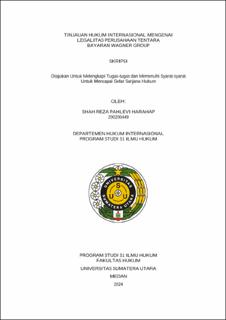| dc.description.abstract | The war in Ukraine which started in 2022 has given rise to new conversations about Private Military and Security Companies (PMSC) and mercenaries. One example is the Wagner Group, which is involved in military operations in various countries. Although they claim their legality under international law, many consider them to be mercenaries, which is prohibited by international law. Several treaties, such as Additional Protocol I to the Geneva Conventions and the International Convention against the Recruitment, Use, Financing and Training of Mercenaries, and the OAU Convention for the Elimination of Mercenarism in Africa provide guidelines for determining their status.
This research focuses on 3 (three) questions, namely: First, what are the provisions for mercenaries according to international law? Second, can the Wagner Group and its activities be called mercenaries? Third, how does the Wagner Group's contract with the hiring party end? This research uses normative, descriptive methods, data collection techniques, namely literature study and data analysis using qualitative methods, namely in the form of in-depth interpretation of legal materials as is common in normative legal research.
The conclusion of this research is that, provisions for mercenaries can be found in the Additional Protocols I of the Geneva Convention, the International Convention Against the Recruitment, Use, Financing and Training of Mercenaries, OAU Convention for the Elimination of Mercenarism in Africa. The Wagner Group and its activities in the Ukrainian armed conflict can be considered legitimate combatants, but not in Libya, the Central African Republic and Mali. It was also found that the activities of the Wagner Group in Libya, the Central African Republic and Mali correspond to the definition and characteristics of mercenaries but not in Ukraine and also that the Wagner Group contract had expired in and the replacement of Wagner with a new force called the Africa Corps in Africa was being implemented. | en_US |


